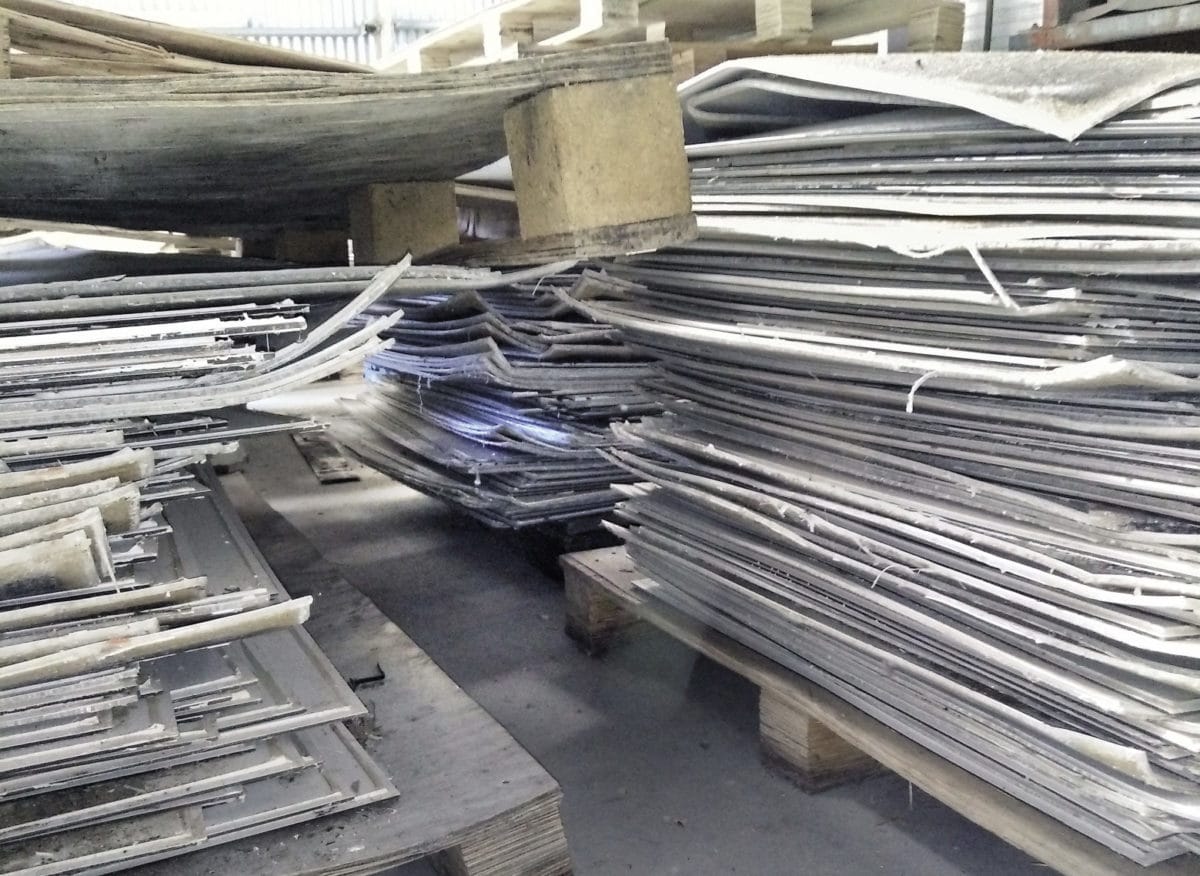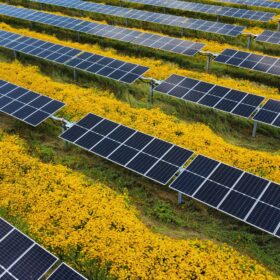From pv magazine’s global site.
The presence of hazardous materials in the end-of-life solar panels can result in significant pollution and health issues, if released into the environment. To close the loop in the energy cycle, the next mission of the solar panel industry is the safe disposal or recycling of end-of-life products. In the waste management hierarchy, however, re-use or value-added recovery/re-purposing is considered preferable to recycling.
The main contributor to the total weight of a typical crystalline silicon PV module is glass (75%), followed by polymer (10%), aluminum (8%), silicon (5%), copper (1%) and small amounts of silver, tin, lead, and other metals and components. Lead and tin, if leached into soil and groundwater cause health and environmental concerns, while copper, silver, and silicon present a value opportunity if recovered efficiently. So, the landfill option should be fully replaced with recycling to prevent environmental pollution and retrieve the valuable materials present in the panel.
(pv magazine spent Q4 2019 looking at the use of lead in c-Si modules as a part of its UP initiative. Topics included the use of lead in perovskites and lead alternatives. Read more, stay tuned and get involved!)
Currently, however, recycling cannot be considered the economically favorable option, so economic incentives are required to accelerate this displacement. Among the valuable materials in the panel, silicon presents the best opportunity, given its considerably larger fraction and its ultra-high purity (99.9999% or six nines/6N). The solar-grade silicon from PV waste can be recovered for second-use applications in solar panels or repurposed for value-added application in the anodes of advanced lithium-ion batteries.
One industry’s pain could be another industry’s treasure
The growing number of electric vehicles has presented an opportunity to the materials recycling world and waste management industry; and there may be room for used solar panels too. Today’s EV batteries are an essential part of the total EV cost (33% to 57% depending on the car), and materials production is the dominant contributor to the energy cost of making the batteries. Cost-cutting strategies rely heavily on innovations at the materials level, i.e. raw materials sourcing and processing.
While EV fans definitely welcome lower prices, setting mileage records is what makes headlines. In 2015, Elon Musk claimed that silicon in Model S batteries increased the car’s range by 6%. Ever since, EV companies like Daimler and BMW have also been actively engaged in research and development programs to synthesize battery-grade silicon for EV applications. Silicon recovered from the solar panel may just be what they need.
Australia can play an even more influential role
Australia has always placed well among the fast-expanding PV markets such as China, Japan, India, and the U.S. Now with more than 2.3 million rooftop solar power systems installed across the country, Australia officially ranks first.
The other thing we have in common with these countries is not, unfortunately, something to brag about: Recycling of end-of-life PV modules is not regulated in Australia. In fact, Europe is the only region that has a robust and transparent regulatory framework to support the PV recycling process. As of mid-2012, the recast WEEE (Waste Electrical and Electronic Equipment) Directive 2012/19/EU mandates European countries to adopt PV waste management programs where producers are responsible for the take-back and recycling of the panels they sell.
The goal of these policies is to develop greener products, and make recycling more affordable and economically sustainable by leading producers to factor in the cost of the collection and end-of-life treatment of their products into the price paid by the consumers.
In Australia, we are working on it, throughout a national program led by the Victoria state and in close relation with the PV industry. The goal is to make recommendations to states, territories, and federal governments on a preferred national management approach. While the outlooks of the program are undoubtedly promising, accelerating the development of it may be critical. In fact, the criticality of the issue was recognised in 2015, when solar panels were identified as the fastest-growing e-waste stream without dedicated recycling infrastructure in the Victorian e-waste market flow and processing capacity analysis.
It is expected that more than 100,000 tons of solar panels will enter Australia’s waste stream by 2035. Is this a crisis or an opportunity? If you look up solar panel recycling in Australia, there are a number of services. However, mostly they can recycle less than 20% by weight – the aluminium frame and the terminal boxes. Recycling the remaining 80%, including the precious silicon, is not currently offered in Australia, but it does not have to remain like that.
You can only do what you can sell
While as users,we can’t do much but rely on responsible recycling businesses to properly dispose of solar panel waste, as scientists and engineers, we may be able to do more. Providing scientific evidence on the potential impacts and benefits of recycling PV panels could incentivize the government and industry.
Our collaborative study with The Group of Research in Energy and Environment from Materials at the University of Liege in Belgium, provides such evidence. Evidence that in the future, end-of-life solar panels may prove to be a valuable secondary resource for a critical material in electric-vehicle batteries: Ultra-pure Nano-structured Silicon.
The process of recycling silicon modules in Europe began more than a decade ago; however, the problem associated with most processes developed to date is that the recovery rate is not more than 80% and the value of the retrieved materials is not competitive compared to the originals.
As part of this program, the university group patented a greener, more cost-effective method of dismantling the PV modules; namely by avoiding the high temperatures (450-600°C) usually employed for burning the materials. This new hydrothermal recycling method, which is conducted at temperatures below 200°C prevents the combustion of halogenated-polymers and the vaporization of heavy metals such as tin, lead, and silver; hence avoiding the waste gas treatment step.
Just as important, the use of moderate temperatures prevented the melting and diffusing of metallic contacts components into other photovoltaic components, such as glass and silicon wafers, which bypass the purification steps necessary for the recovery of high purity silicon and glass. The simple and scalable dismantling process was tested on several PV brands, and advantageously offered clean glass, which was made available to relevant industries to evaluate the value of the recovered material.
A new discovery, published in the Journal of ACS Sustainable Chemistry & Engineering, reports on the simple and economic recovery of nano-structured silicon from end-of-life PV panels with demonstrated value-added applications in lithium-ion batteries.
As scientists, we cannot do much marketing, but we can provide evidence that if you recycle properly, you can sell.
About the author
Dr. Mahdokht Shaibani has a PhD in Mechanical Engineering, with a focus on energy storage from Monash University, Australia.
The views and opinions expressed in this article are the author’s own, and do not necessarily reflect those held by pv magazine.
This content is protected by copyright and may not be reused. If you want to cooperate with us and would like to reuse some of our content, please contact: editors@pv-magazine.com.








20 year life for solar panel? I don’t think so.
Also, this article from the parent PV Magazine about an Italian company claiming 99% recycle of a solar panel in as little time as 40 seconds using mechanical means was interesting:
https://www.pv-magazine.com/2020/04/01/a-mechanical-technique-for-pv-module-recycling/
The reality of solar PV is one could put a new system on their roof today, the local neighborhood “Dennis the Menace” could think its a good idea to shoot the panels with his slingshot or BB gun and crack all of the panels. My first solar PV system made it 12 years, through a few hail storms over the years without a problem, when I sold the house and moved on. There are still old ARCO solar PV panels made in the 1970’s that are still in use today. Many of the solar PV manufacturers have gone from a 25 year stepped warranty period to a 30 year linear warranty period. At the prices per watt for solar PV at the $1.25/watt all the way down to $0.70/watt retail, today one can afford to overbuild their solar PV system and design for a 50 year service life without breaking the bank. If in the near future where there are no longer tariffs on “foreign solar PV panels and technology”, then with manufacturing runs of thousands of solar PV panels bidding at 17 cents to 25 cents/watt could see retail costs at the 40 to 55 cents/watt panels. New technology that ‘may’ be available within five years like tandem solar cells with efficiencies of 30% to 40% solar harvest would again bring down the price of solar PV and allow relatively large solar PV systems on more roofs across the nation.
I would have changed my panels to replace them with more efficient ones. They have bee in 12 years but so far have not covered their costs. If I change them my income will drop by about£900 annually.
If I keep on using them the should pay after 22 years.
It is alarming to know about the pollution caused by the solar panels after its usage for several years. It seems to be a severe recycling crisis that several countries would face in the future. It is high time that we think about reusing the used solar panels just like the reuse of used shipping containers for waste management. Thanks for the post.